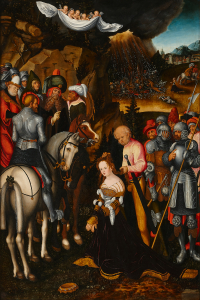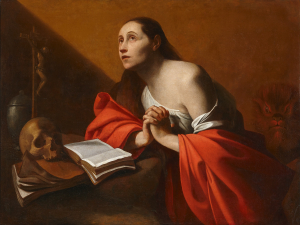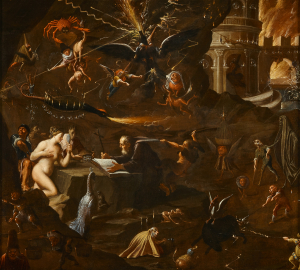Anonymous Flemish Mannerist, The Fall of Man
Anonymous Flemish Mannerist, The Fall of Man
This large portrayal of the Fall of Man was painted in the sixteenth century, and shows us the decisive moment when evil first came into the world. Adam stands to the left of the tree; Eva, on the right, is handing an apple to Adam while picking a second for herself. Curled around the tree trunk, the serpent whispers in Eva’s ear. In the foreground and background we see the Garden of Eden, paradise on Earth, with a variety of animals rampant in a park-like landscape. The handsome little bird and the lizard in the foreground create a strong sense of depth in the painting.
The Biblical story in the Book of Genesis tells us that Adam and Eve lived in the Garden of Eden. Sometime after Creation, a serpent seduced the first woman into picking a fruit from the tree of Good and Evil. God had forbidden Adam to eat the fruit of this tree, warning him that if he and Eve were to do so, they would die. However, the serpent claimed they would not die but that it would open their eyes and they would be as God, with knowledge of good and evil. Ripe and colourful, the fruits in the tree were extremely tempting, and the wisdom that the serpent promised made them all the more desirable. Eva took a bite, and gave a fruit to Adam, who also bit into it. In the arts, the fruit is often represented as an apple, likely because the Latin word malus means both “apple tree” and “bad” or “evil”.
This event is known as the Fall of Man. Adam and Eve proved that they were unable to resist the temptation of evil and chose it over their faith in and loyalty to God, who had given them a life in Paradise. Rather than being grateful and obedient to him, they were rebellious, seeking to be as God, and wishing to determine good and bad for themselves.
The consequences were severe: their relationship with God was compromised. They became aware of each other’s nakedness, and it filled them with shame; they covered themselves with leaves and hid away from God. Evil had found a place in the heart of man, and so had mortality. Man had fallen into misfortune. Despite their disobedience, God called Adam and Eve to him, for such was his mercy. He asked whether they had eaten of the tree’s fruit, and the evil within mankind immediately revealed itself: Adam blamed Eve, and Eve blamed the serpent.
The painting’s sixteenth-century audience was well aware of all this, and of the fact that humankind had become mortal as a result. From their perspective, man has sought to shift blame to others rather than be honest and admit to his mistakes and sins, ever since the Fall of Man. The Fall led to the Christian doctrine of original sin, the sin that taints all humanity from birth, as we are all descendants of Adam and Eve. It was a very popular theme in the arts during the sixteenth and seventeenth centuries, forming the subject of many works, especially in sixteenth-century prints.
The painting depicts the moment when Eva hands the apple to Adam. She has already eaten of the fruit, and seeks to cover her nudity. Adam is shown as a strong, muscular, healthy man, in accordance with society’s worldview at the time. The soft, weak female body served to contrast the strength of the male, an effect that is further strengthened in this painting by Eve’s milky white skin.
The traditional composition, with Adam and Eve on opposite sides of the Tree of the Knowledge of Good and Evil, originated with a print by Albrecht Dürer dating from 1504. The central tree in the Garden of Eden occupies the middle of the painting, flanked by Adam and Eve.
As in Dürer’s print, Adam’s gaze is directed to the side, and his right arm leans upon a branch, while his left is outstretched towards Eve. A remarkable detail about this painting is that the painter originally intended to place Adam on the other side of the tree, with Eve standing on the left. This is evidenced by the fact that behind Eve’s face is a painting of Adam’s face. The serpent’s head also originally pointed in the other direction, and its coils wound around the trunk in a different pattern. Although this alternative composition does occur in the arts – Lucas van Leyden created a print in which Adam stands to the viewer’s right, for example – it is much rarer than the reverse. Why the painter changed his mind remains unknown to date, although the client may well have considered the composition a deviation from the norm and did not appreciate it.
Eve’s figure displays many similarities with a print by Crispijn de Passe after Maarten de Vos that first appeared in 1574. The way she passes an apple to Adam while picking a second is the same; however, the orientation of her body is slightly different. As a motif, the lizard in the foreground is familiar only from a print by Hans Sebald Beham; the bird is a very original addition.
Dendrochronological research has shown that the panel must have been suitable for painting from 1549 onwards. However, based on Adam’s and Eve’s postures, the painting more likely dates from around 1575. The as-yet-anonymous painter managed to create this large portrayal of the Fall of Man in a very unique manner that nevertheless fit into the visual traditions of the time.
- Period
- ca. 1575
- Material
- oil on panel
- Dimensions
- 123.5 x 92.3 cm
Global shipping available









